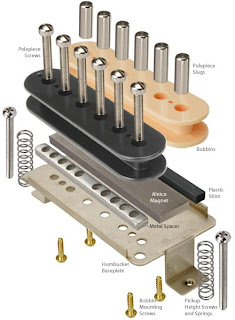 |
| Humbuckers Dissected - image from StewMac.com [1] |
Whether it's classic crunch or full on tonal meltdown you're looking for the Humbucker can get you there - with the added bonus of no "added" 60Hz hum that is associated with P90 and Single Coil pickups :-D
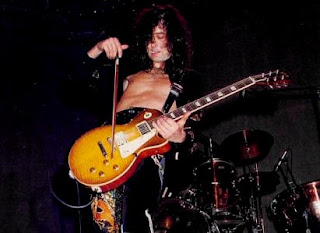 |
| Jimmy Page of Led Zeppelin with his Humbucker equipped Les Paul |
So what is a "humbucker" and where did the design original from?
By the early 1950's Gibson was being directly challenged by Fender as the major producer of quality solid body electric guitars, to counter the Fender charge on the market Gibson decided to develop a high quality, low noise pickup with which to equip their newly introduced "Les Paul" model guitar. Seth Lover was the engineer assigned with the task of developing this new product. In order to solve the inherent noise problems of the P90 and single coil pickups Lover decided upon connecting two side by side single coil pickups in series but with opposite magnetic polarities and opposite current travel in either coil. The product he developed changed the sound of electric guitar forever - the Humbucker was born!
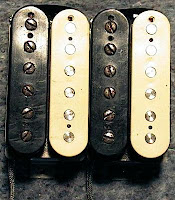 |
| Original "Zebra" P.A.F Humbuckers [2] |
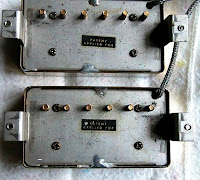 |
| Original Gibson P.A.F humbuckers with black decal [2] |
"Seth Lover received his pickup patent #2,896,491 on July 28, 1959. By mid to late 1962, Gibson changed the pickup decal to read, "PATENT NO 2,737,842". Interestingly the patent number listed on the decal was not for Seth's pickup design but was for Les Paul's trapeze tailpiece! Perhaps this was a research roadblock for the competition, or maybe just a mistake?" [2]
And an extract from the actual humbucker patent granted to Seth Lover:
 |
| An extract of the original Humbucker Patent filed by Seth Lover |
Now we know where the original P.A.F came from I'll offer a quick explanation of how the technology works to give us a general idea of what is going on between those coils!
The image below shows how the humbucker pickup is laid out:
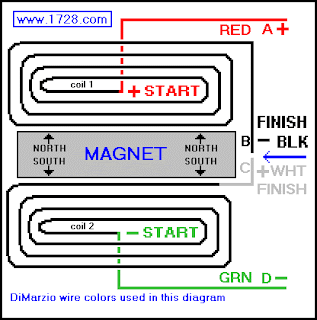 |
| (fig.1) Basic Drawing of a Humbucker Pickup [3] |
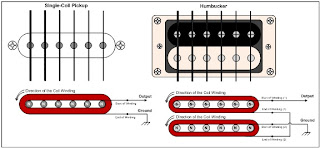 |
| Single coils Vs Humbuckers |
(with reference to fig.1) "Coil 1 and coil 2 are electrically out of phase and since electrical interference only travels through the guitar pickup's windings, when the hum travels from one coil to the other, it gets canceled due to the opposite coil windings. (The magnets play no part in hum cancelation.)
Unlike hum, an electric guitar's sound (the signal) is generated from the pickup's wiring and magnets. So, when the guitar signal travels through the coils, no cancelation occurs because the coils are out of phase electrically and magnetically.
In effect, having opposite electrical and magnetic polarities is similar to putting two phase switches on two pickups. When both switches are set to the out of phase positions, no cancelations occur because the 2 "out of phase" conditions cancel each other out." [3 - http://www.1728.org/guitar1b.htm]
Wikipedia (although I do dislike referencing wikipedia!) also has some useful info (al be it slightly incorrect - my edits in brackets []):
"In any magnetic pickup, a vibrating guitar string, magnetized by a fixed magnet within the pickup, induces an alternating voltage across its coil(s). However, wire coils also make excellent antennae and are therefore sensitive to electromagnetic interference caused by alternating magnetic fields from mains wiring (mains hum [60 Hz hum]) and electrical appliances like transformers, motors, and computer screens. Guitar pickups reproduce this noise, which can be quite audible, sounding like a constant hum or buzz.
The direction of a voltage induced across a coil by the moving string depends on both the coil winding direction and the direction of the fixed magnets. A humbucker has two coils wound in the [same direction but with opposite directions of current travel]. The magnets in the two coils are arranged in opposite directions so that the string motion induces voltages across both coils in the same direction. Electromagnetic interference, on the other hand, induces voltages in opposing directions across the coils because it is only sensitive to the winding direction. When the signals from both coils are summed together, usually by connecting the coils in series, the two noise voltages cancel, while the signal voltages add thus dramatically improving the signal-to-noise ratio." [4 - http://en.wikipedia.org/wiki/Humbucker#How_humbuckers_work]
Still not sure what differentiates a single coil pickup from a humbucker? Check this video out:
Back to the P.A.F - Design considerations
Now, many guitarists go crazy for the original P.A.F tone, the original pickups sell for hundreds and examples of late 50s and early 60s Gibson guitars with P.A.F humbuckers sell for tens of thousands. Many of todays boutique pickup manufacturers offer a straight clone of the P.A.F and charge a healthy price for it. Below is a video of the (very nice!) Bare Knuckle Pickups "The Mule" which is a faithful reproduction of the original P.A.F:
So how were the originals made and what makes them sound the way they do? Firstly lets refresh ourselves with the humbucker and it's components, fig 2 shows you all the internal parts of the humbucker:
As you can see from fig 2 there aren't a huge amount of parts involved in the construction of a humbucker. However the parts do need to be put together concisely, taking into account a number of key tonal factors to ensure a decent sounding pickup is produced. These tonal factors are wide ranging and cover all aspects of the pickup's design and construction and, indeed, many guitarists will insist that very strange factors (with no scientific or technical evidence to support their claims) will affect a pickup's tone (e.g - it was made on a Tuesday by "Ron" - it's all in the "mojo"). However, we're not interested in the far out theories on tonal excellence regarding the P.A.F humbuckers, we're interested in the *real* reasons the P.A.F humbuckers sound the way they do and these, with reference to various sources, are [5][6][7]:
Now, lets investigate each of these factor in more depth. Firstly;
Magnet Type
The type of magnet that a humbucker uses is one of the most important factors in deciding it's overall tone. There are essentially two types of magnet that are widely used in humbucking pickups; ceramic and alnico (aluminium, nickel and cobalt alloy). The key factor in determining the tone that a magnet will impart upon a pick is it's overall magnetic strength. The strength of a magnet is noted by the number after it's material; the higher the number the higher the magnet strength. Ceramic magnets are more powerful than alnico and due to the increased cost of higher strength alnico magnets they are usually selected when you need more power than an alnico 5 magnet (although you will see Alnico 6 and 8 pickups about). So what difference does this increase in magnet power make to the tone of the humbucker? Generally the higher the strength of the magnet the more emphasis on the highs and upper mids, this usually sees higher strength magnets being described as "bright" and "brittle".
Humbuckers that utilise coils wound with a higher DC resistance and therefore a hotter output often use stronger magnets, and their increased high end response, to compensate for the inherent high end losses caused by the hotter coil windings.
Here's a concise description of the differences between alnico and ceramic from the GuitarTechCraig website:
"Alnico was used in all popular vintage pickups and generally has a warm and smooth response. Ceramic magnets tend to boost treble response and have become popular for pickups with extra coil winding to compensate for the treble loss. Alnico magnets also lend to a smoother distortion tone with a prominent midrange while ceramic magnets can improve the clarity and high end grind of a distorted tone. There are many different formulas of Alnico and Ceramic magnets. In general, the stronger the magnet can be magnetized, The brighter it will sound in a pickup." [9]
Furthermore, Tim, from Bare Knuckle Pickups, offers this more in depth break down and description of the various magnet types:
"Magnets do add to the character of a pickup although it must be understood that a magnet doesn't have a sound on it's own, it contributes by the way it accentuates certain frequencies as current is produced in the coil windings.
The direction of a voltage induced across a coil by the moving string depends on both the coil winding direction and the direction of the fixed magnets. A humbucker has two coils wound in the [same direction but with opposite directions of current travel]. The magnets in the two coils are arranged in opposite directions so that the string motion induces voltages across both coils in the same direction. Electromagnetic interference, on the other hand, induces voltages in opposing directions across the coils because it is only sensitive to the winding direction. When the signals from both coils are summed together, usually by connecting the coils in series, the two noise voltages cancel, while the signal voltages add thus dramatically improving the signal-to-noise ratio." [4 - http://en.wikipedia.org/wiki/Humbucker#How_humbuckers_work]
Still not sure what differentiates a single coil pickup from a humbucker? Check this video out:
Back to the P.A.F - Design considerations
Now, many guitarists go crazy for the original P.A.F tone, the original pickups sell for hundreds and examples of late 50s and early 60s Gibson guitars with P.A.F humbuckers sell for tens of thousands. Many of todays boutique pickup manufacturers offer a straight clone of the P.A.F and charge a healthy price for it. Below is a video of the (very nice!) Bare Knuckle Pickups "The Mule" which is a faithful reproduction of the original P.A.F:
So how were the originals made and what makes them sound the way they do? Firstly lets refresh ourselves with the humbucker and it's components, fig 2 shows you all the internal parts of the humbucker:
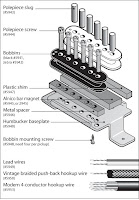 |
| fig 2. Internal humbucker structure |
- Magnet type,
- Wire quality, gauge and insulation,
- Number of coil windings,
- Baseplate and covering,
- Overall coil shape,
- Coil winding pattern, and
- Potting.
Now, lets investigate each of these factor in more depth. Firstly;
Magnet Type
| Humbucker magnets - from left; ceramic, alnico 5, 3 & 2. [8] |
Humbuckers that utilise coils wound with a higher DC resistance and therefore a hotter output often use stronger magnets, and their increased high end response, to compensate for the inherent high end losses caused by the hotter coil windings.
Here's a concise description of the differences between alnico and ceramic from the GuitarTechCraig website:
"Alnico was used in all popular vintage pickups and generally has a warm and smooth response. Ceramic magnets tend to boost treble response and have become popular for pickups with extra coil winding to compensate for the treble loss. Alnico magnets also lend to a smoother distortion tone with a prominent midrange while ceramic magnets can improve the clarity and high end grind of a distorted tone. There are many different formulas of Alnico and Ceramic magnets. In general, the stronger the magnet can be magnetized, The brighter it will sound in a pickup." [9]
Furthermore, Tim, from Bare Knuckle Pickups, offers this more in depth break down and description of the various magnet types:
"Magnets do add to the character of a pickup although it must be understood that a magnet doesn't have a sound on it's own, it contributes by the way it accentuates certain frequencies as current is produced in the coil windings.
Alnico II is the softest and generally has a smooth bass and treble although this is more pronounced the hotter the windings get.
Alnico III is very transparent, low output and clean,sounds great for rounded fat jazz applications-typical of '50s tone.
Alnico IV is probably the best vintage tone IMHO(for humbuckers) and along with II and III was used in the earliest PAFs-this is a fact and not myth as we've had them analysed and a collegue of mine has also seen original Gibson purchase orders that clearly state AIV bar stock being purchased.The tone of AIV is balanced and extremely organic, it produces the most authentic vintage tone and sits better in slightly hotter vintage winds than AII which tends to get very soft in the bass and highs if used incorrectly.
Finally Alnico V is the hottest producing more highs and lows, great for rock applications or where power and cut are important.
Different companies use different grades for personal reasons, we use all of the applicable Alnico grades to suit the correct design, both to be historically correct but more importantly to have the best sound.
Changing magnets in a humbucker can give dramatic results, you soon find the ones that really don't sit right and others that are head and shoulders better........
[regarding ceramic magnets]
We use ceramic 8 as do most pickup makers-it is more powerful and essentially more efficient so the resulting tone usually has a very fast tracking bass response with a distinct cut in the highs.Some players find them cold/hard when run clean and they can cause alot of compression from their relatively hot output-again, depending on how you use them, they are capable of good clean tones too but the general consensus is that Alnicos are sweeter run clean." [10]
This Bare Knuckle Pickup's video provides and insight into the differences between ceramic and alnico magnets and gives you and idea of how magnet strength affects the overall tone of the humbucker:
So, there are the differences in magnet types. Getting back to the P.A.F; what did the original use? Well, inconsistency was king at Gibson in the late 50s and 60s and a range of magnets were used; Alnico 2, 3, 4 & 5. It is suspected that the majority of P.A.F era humbuckers utilized alnico 4 (IV) magnets as backed up by Tim from Bare Knuckle Pickups;
"Ask Gibson historian Walter Carter to look up the purchase orders for the mid to late '50s for magnet bar stock or ask Tom Holmes(ex Gibson) who's also seen the records which show Alnico IV bar stock being purchased during this period.The X ray spectrograph analysis showed a 1959 PAF humbucker magnet as being Alnico IV."
Tim also uses the Alnico 4 magnets in his "The Mule" P.A.F replica. This inconsistency in magnet type continued at Gibson right through the late 50s and early 60s, however by 1965 Gibson was using Alnico 5 magnets in all their humbuckers. [2]
You should also take into account the size of the magnet; "The original PAF magnet length was 2.5" long, which was decreased by 1/8" to 1/4" to around 2.25" in July 1961." [2]
And further more;
"Dimensions of PAF magnets follow (measured using a micrometer, and obviously this will vary a bit from magnet to magnet): 2.509" long ("long magnet" version), .506" wide, .131" thick. The "short magnet" PAF length was the a bit different: 2.371" long, .491" wide, and .121" thick." [2]
You should also take into account the size of the magnet; "The original PAF magnet length was 2.5" long, which was decreased by 1/8" to 1/4" to around 2.25" in July 1961." [2]
And further more;
"Dimensions of PAF magnets follow (measured using a micrometer, and obviously this will vary a bit from magnet to magnet): 2.509" long ("long magnet" version), .506" wide, .131" thick. The "short magnet" PAF length was the a bit different: 2.371" long, .491" wide, and .121" thick." [2]
Wire Quality, Gauge and Insulation
 |
| Different wire types - note the plain enamel insulated and it's purple colour wire to the right. |
Take this description from skguitar.com, which covers everything in general about humbucker wire selection:
"The finer the wire the fewer highs pass through. Finer wire also has a higher resistance for a given length. For this reason a pickup wound to 6k with 43awg [thinner] wire will have less output than a pickup wound to 6k using 42awg [thicker] wire. Regardless of what has been said I do no believe there is any difference based upon type of insulation alone. However, wire with a heavier insulation (i.e. "double build") will result in a wider coil at the same resistance/output [altering the coil shape alters the tone too].
As you can see the choice of insulation has no direct impact on the tone of a humbucker, it may, however, have an indirect impact on tone due to alterations in coil shape and thickness.
So, once again - back to the original P.A.F; what type of wire was used in their construction?
It is widely acknowledged that the original P.A.Fs were wound with 42AWG wire with a plain enamel (which gives it a purply colour);
"The pickups were wound with #42 plain enamel wire. On original PAFs the bobbin wire appears purple, versus later PAF and patent# pickups that appear reddish. Gibson eventually switched to polyurethane coated wire around 1963." [2]
Also note you want good quality wire that has a regular gauge without large fluctuations and without any voids associated with the tooling of wire. If you can get wire that has been annealed (heat treated to remove voids and defects associated with tooling) you're onto a winner!
Number of Coil Windings / DC Resistance
 |
| Winding a pickup bobbin |
The more windings on a coil the higher it's DC resistance, inductance and output. A higher number of windings gives a more girthy, mid range dominated pickup while more highs are rolled off due to an increased coil inductance and capacitance. Take this explanation from the MusicalIlluminism blog;
So what are the specs on the vintage P.A.F?
"Due to the human factor and the wide tolerance of the manually-run pickup winding machines used by Gibson from 1956-1961, PAF pickups usually measure between 7.5 and 9.0 thousand ohms (K ohms). By 1962 (the end of the PAF era), Gibson was making pickups very consistently with 7.5k ohms of wire (give or take .25k ohms).
The separate bobbins of a PAF can measure very differently due to Gibson's manufacturing techniques. For example one bobbin could measure 3.5k, and the other 4.5k ohms (for a total of 8k ohms). This mis-matched ohms is actually a good thing, as certain frequencies will stand out if both bobbins have different resistance. This contributes to why two PAF pickups can sound quite different." [2]
The separate bobbins of a PAF can measure very differently due to Gibson's manufacturing techniques. For example one bobbin could measure 3.5k, and the other 4.5k ohms (for a total of 8k ohms). This mis-matched ohms is actually a good thing, as certain frequencies will stand out if both bobbins have different resistance. This contributes to why two PAF pickups can sound quite different." [2]
As you can see there is a mention of mis-matched coils, usually humbuckers sound best if the the bridge humbucker has it's slug coil wound with a higher resistance than the screw side, this gives it slightly more mid grunt and avoids it becoming to treble heavy. For a neck pickup the opposite is true, with the screw side overwound the emphasis is more on the open strings of the neck and gives a more open and natural tone (the emphasis is on the part of the string that you want to hear!). [13] This is personal preference though and if you play about with which coil you offset you'll find your favourite. I'd try winding with offsets from a few hundred turns right up to a thousand turns (I, personally, usually go for about 250-300 turns offset). For further insight take this explanation into coil offsets from Tim, of Bare Knuckle Pickups;
"Coil offsets do effect mid range but not quite to the extremes you may think. What's actually happening is the moment there is asymmetry between the coils phase cancellation isn't 100% any more. Aurally this means more highs come through and the 'perception' of midrange alters.If I wound 2 coils with 5000 turns each they would be perfect humbuckers and cancel out 50/60 cycle hum efficiently. If I wound 5150 and 4850 which would produce almost the same DC reading, you'd hear high end which balances against the mid range giving the impression of it dropping back. As you're no doubt aware when you use a graphic EQ, altering the phase of one cycle tends to knock the phase of the others-how much is perceived and how much actual I wouldn't like to hazard a guess as it'd take some serious analysis to verify.
Bottom line, anything to do with altering coil shape, size, no. of winds, offsets between coils etc will effect tone.
Before anyone panics about offset coil pickups not being 100% true humbuckers, panic not..........in my experience you can offset coils by as much as 1000 turns before noise becomes audible.This is dependant on wire gauge and overall no. of turns.................generally the offsets we use are nothing as extreme and no noise is audible at all." [14]
"Coil offsets do effect mid range but not quite to the extremes you may think. What's actually happening is the moment there is asymmetry between the coils phase cancellation isn't 100% any more. Aurally this means more highs come through and the 'perception' of midrange alters.If I wound 2 coils with 5000 turns each they would be perfect humbuckers and cancel out 50/60 cycle hum efficiently. If I wound 5150 and 4850 which would produce almost the same DC reading, you'd hear high end which balances against the mid range giving the impression of it dropping back. As you're no doubt aware when you use a graphic EQ, altering the phase of one cycle tends to knock the phase of the others-how much is perceived and how much actual I wouldn't like to hazard a guess as it'd take some serious analysis to verify.
Bottom line, anything to do with altering coil shape, size, no. of winds, offsets between coils etc will effect tone.
Before anyone panics about offset coil pickups not being 100% true humbuckers, panic not..........in my experience you can offset coils by as much as 1000 turns before noise becomes audible.This is dependant on wire gauge and overall no. of turns.................generally the offsets we use are nothing as extreme and no noise is audible at all." [14]
And here's another explaination of the offset effect from MDV over at the Bareknucklepickups Forum;
"The hum cancelling effect of humbuckers is a 1:1 turn per turn effect. Turns wound in the opposite direction and powered by magnetic fields going in the opposite direction (RPRW; reverse wound, reverse polarity) cancel the natural noise that each turn makes.
That means that, as nolly alludes to, if wind is assymetric then the excess turns on one side behave as single coil turns because they dont have corresponding turns to cancel them, and have more top and more bottom, but noise is not cancelled. This gives more clarity and depth to the pickup (but mainly clarity/top end).
Its also true that the noise isnt noticable and bk offsets are well below whatever the offset threshold for noise is." [15]
With a little searching I found a few specs for Gibson "Burstbucker" Humbuckers (The Gibson replica of the original P.A.F) and their individual coil windings;
Pickup---------Screw Coil---------Slug Coil
BB-1 ---------- 3.90k -------------- 3.99k
BB-2 ---------- 4.16k -------------- 4.22k
BB-3 ---------- 4.41k -------------- 4.54k
BB-3 ---------- 4.30k -------------- 4.80k
As you can see from these figures the offsets aren't huge; just enough to introduce a little play in the high frequencies. Remember - to much offset and you'll reintroduce 50/60Hz hum back into the pickup!
If you play with higher gain settings you may like both coils to be matched as closely as possible for a smoother more mid dominated humbucker.
Pickup---------Screw Coil---------Slug Coil
BB-1 ---------- 3.90k -------------- 3.99k
BB-2 ---------- 4.16k -------------- 4.22k
BB-3 ---------- 4.41k -------------- 4.54k
BB-3 ---------- 4.30k -------------- 4.80k
As you can see from these figures the offsets aren't huge; just enough to introduce a little play in the high frequencies. Remember - to much offset and you'll reintroduce 50/60Hz hum back into the pickup!
If you play with higher gain settings you may like both coils to be matched as closely as possible for a smoother more mid dominated humbucker.
Regarding the total DC resistance, you can see the original P.A.Fs vary between 7.5K and 9K. I wind my bridge humbuckers to 8.3-8.5K and my neck humbuckers to 7.3-7.5K. This gives a decent output in the bridge position that breaks up well yet still cleans up with the guitar volume control. The lower output in the neck position gives a more rounded, natural tone with the warmth associated with the neck position.
Baseplate and Covering
If the baseplate is metal and not grounded it will increase the inductance and capacitance of the humbucker, therefore rolling off more highs and adding lows and mids. The cover has the same effect. Now "early P.A.F. pickups as used on the 1956 lapsteels and 1957 Les Paul Standard had brushed stainless steel pickup covers (brushed to make them look nickel plated). This quickly changed to brass covers with a nickel plating. If the cover was gold, the brass was first nickel plated and then gold plated. Early PAFs also have four brass bobbin attachment screws, instead of steel screws." [2]
On pickups I've built I've always used Nickel Silver base plates and Nickel Silver covers and they've always sounded good. The difference between covered and uncovered humbuckers is illustrated nicely in this video:
You can hear the subtle differences - the slight increase in highs of an uncovered pickup versus the rolled off highs and increase in mids of the covered pickup. The choice is yours!
Overall Coil Shape
 |
| Short fat coil bobbins |
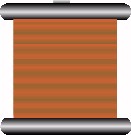 |
| Tall thin coil bobbins |
Now, all humbucker bobbins are made a standard height, the only difference will be in the width of the coil. The use of a thicker gauge wire will increase the width of the coil, a lower or higher winding tension will also alter the shape of the coil as will the use of wire with thick insulation.
A well wound medium tension coil from 42AWG plain enamel insulated wire should produce the classic P.A.F coil shape; a full but not overwound bobbin.
Coil Winding Pattern
A pickup wound by machine will have a very regular and even wind pattern, a pickup wound "by hand" (i.e guided onto the bobbin by hand) will have a much less regular wind pattern - this is called "scatter winding" and many guitarists believe it gives a much superior tone when compared to regular machine wound pickups. Tim, of Bare Knuckle Pickups, scatter winds all of his pickups;
"Scatter-winding can only truly be done by hand and represents a high degree of skill by the person winding the coil. Although time consuming, it has many advantages over conventional machine winding and mass-production, not least the far superior tone and dynamics produced. We deliberately scatter the wire as we build up the windings of the coils so the wire isn't as even turn on turn, layer on layer, as with the more uniform wind of an automated machine with pre-tensioning. This lowers the distributed capacitance that exists between the turns of wire. Lower capacitance means improved high-end clarity, the resonant peak increases slightly and frequency response is greatly extended. The tension of the wire is also varied as it moves through the operator's fingers reflecting the ability to control the tension within the coil by the person winding the pickup. The result is a clearer, more open tone that has the impression of being louder purely by the amount of extra detail and dynamics present." [12]
The original P.A.Fs were machine wound but the use of scatter winding is certainly one way to improve upon the tone. Lets face it - if we're winding our own pickups they are going to be "scatter wound" unless we have access to a proper pickup winding machine.
Potting
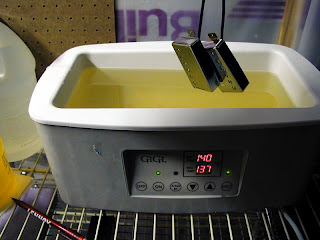 |
| Potting humbuckers in wax |
Potting involves dipping the finished pickups in wax or other similar materials (epoxy or lacquer) to solidfy the coil windings and remove unwanted microphonic feedback (those horrible squeals you sometimes get at high gain). The original Gibson P.A.F humbuckers were not potted but most modern reproductions are. I always pot the humbuckers I wind, it's a simple process (submerge the pickups for 10 mins in parafin wax at 65 degrees centigrade) and in my opinion the positives out weigh the negatives. But don't take my word for it. Once again with reference to Bare Knuckle Pickups;
"Unpotted coils have a very dynamic and touch-sensitive feel with a brighter edge which is well-suited to low gain playing, while potted coils have better feedback rejection and are much more practical for any playing style where high amounts of preamp gain and loud volume are used. We do make pickups with unpotted coils as an option, although we lacquer the magnet and use paper tape inside the cover to help reduce squealing, just as in the early humbuckers.
Historically, not all pickups were potted but with modern high gain amplifiers and performance this isn't always practical. Nearly all our finished coils are potted in a mixture of paraffin wax and bees wax to remove unwanted air trapped in the coil, solidify the windings and prevent microphonic feedback. All of our high gain models or any pickups that require metal covers are wax potted a second time to eliminate any chance of microphony." [12]
Once again, this choice is yours!
So there you have it; how humbuckers came about, how they work and how the various design considerations effect the overall tone that the humbucker will produce. Below are some specs for the various Gibson P.A.F era humbuckers.
Various Gibson P.A.F era Humbucker specs
"1956 – 1957 (“PAF”): Long (2.5”) Alnico 2, 3, 4 and 5 magnets used randomly, brushed stainless steel cover, *no* PAF sticker, automatic traverse wound with manual-stop (until bobbin was “full”), #42 plain enamel wire (purple/maroon), individual coil ohm differences, black leads on coils, ohms vary from low 7k to high 9k, black PAF-style bobbins (“square in circle” with holes). PAFs first installed on Gibson lap-steels in ‘56 and then guitars in ‘57.
1957 – 1961 (“PAF”): Long Alnico 2, 3, 4 and 5 used randomly (A2 most common), nickel cover, “Patent Applied For” sticker, automatic traverse-wound with manual-stop, #42 plain enamel wire (purple/maroon), individual coil ohm differences, black leads on both coils, ohms vary greatly – generally between 7k and 10k, black and cream (early-’59 thru mid-‘60), all bobbins black again by late ’60, PAF-style pickup bobbins.
1961 – 1962 (Late “PAF”): Smaller (2.37”) Alnico 5 magnet used for remaining production (all transitioned by July ’61), nickel cover, PAF sticker, automatic traverse-wound with manual-stop, #42 plain enamel wire (purple/maroon), black leads on both coils, individual coil ohm differences, ohms averaged 8.0k by ‘62, PAF-style bobbins." [11]
References;
[1] - http://www.stewmac.com/shopby/product/5961?tab=Pictures
[2] - http://home.provide.net/~cfh/paf.html
[3] - http://www.1728.org/guitar1b.htm
[4] - http://en.wikipedia.org/wiki/Humbucker#How_humbuckers_work
[5] - http://www.skguitar.com/SKGS/sk/pickup_factors.htm
[6] - http://www.seymourduncan.com/tales-from-custom-shop/
[7] - https://bareknucklepickups.co.uk/main/howwemakethem.php
[8] - http://www.projectguitar.com/tut/barmagswap.htm
[9] - http://www.guitartechcraig.com/techpckp/pickups.htm
[10] - https://bareknucklepickups.co.uk/forum/index.php?topic=8005.0
[11] - http://musicalilluminism.wordpress.com/2009/04/28/vintage-gibson-humbucker-specs-and-general-pickup-tech/
[12] - https://bareknucklepickups.co.uk/main/howwemakethem.php
[13] - http://www.zhangbucker.com/humbuckers.html
[14] - https://bareknucklepickups.co.uk/forum/index.php?topic=4582.0
[15] - https://bareknucklepickups.co.uk/forum/index.php?topic=22683.0

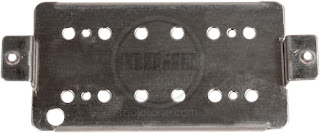
Hi My name is John and I would like to know if you could help me out with what does the red green black and white wires are for on a Gibson Humbucker is for.Like is the red the hot wire or the black one and on. thank you for your time with this. My email is njmn51@aol.com PS this is concerning a 2012 Gibson Les Paul Standard.
ReplyDeleteThe front pickup on my 1975 Gibson L6-S has the red wire going to ground and black to selector switch. Does anybody know why? This guitar does have a six way selector switch that goes in and out of phase. The rear pickup has orange to ground and red and black to selector switch. HELP! CONFUSED! Wire diagrams are confusing because their not color coded.
ReplyDeleteI seriously think you guys should visit BILL LAWRENCE's page, as he's an engineer and not some commercial bulsshit meister.
ReplyDeleteBy reading his page about pickup myths, you'll learn why scatterwinding doesn't "change" tone, or at least you'll have a wider bobbin than if you had machine wound it, worse, by scatterwinding, you can short wires by wearing out the insulation and thin out sections of the hair thin wire, endangering the bobbin's integrity.
One mistake you are making concerning mismatched coils is that they are not always supposed to have a different number of turns (see dimarzio patents) : you can produce a pickup comprised of 2 offset bobbins which have exactly same number of turns if you choose a different wire GAUGE for each bobbin, and mismatching can comprise as well choosing different symmetries for each given bobbin.
All these ideas have been patented by various companies and show that mismatching is not only a business of "turns only" : a real mismatched humbucker which bucks hum as well as a non -mismatched humbucker is theoretically possible as long as you keep the same number of turns and respect polarity issues while connecting bobbins and placing the magnet.
I'm sorry I forgot the link to Willy Stitch's page , here it is, it's called PICKUPOLOGY and many pickup myths are truly debunked .
ReplyDeletehttp://www.billlawrence.com/Pages/All_About_Tone.htm/Pickupology.htm
Note that Bill Lawrence is keeping his head cool, he's not promoting any form of design over another, he's just preventing people from believing false assertions that have no scientific background as many can be found on so many guitar sites unfortunately. I'd take his advise as technicallities to bear in mind when designing a pickup
Considering "ceramic" magnets used in pickups, they're just simple ferrite magnets and aren't "more powerful" than alnico types, they have higher COERCIVE FORCE compared to alnico (ferrite magnets are more difficult to de-magnetize than alnico, that's what it means) but in terms of magnet maximum energy, most alnico grades outclass ferrite magnets ("ceramic") .
what is to consider with alnico vs ceramic (barium or strontium ferrite) is that there is an enormous difference in terms of ELECTRICAL CONDUCTIVITY and in COERCIVITY.
It's not a question of ceramic being "harsh" in itself, as Bill LAwrence explains, you can always create a pickup design where ceramic or alnico will sound smooth or harsh, iot's all design dependant. Many PAFs were made with ceramic for example, and were (and are still) used by jazzmans, while deathmetal guitarists are not all playing with ceramic high output pickups: many swear by low-medium output with alnico grades and rely on AMPLIFIER DISTORTION for the gritty sound. Still, some low output PUs are designed with ceramic magnets (and new designs even have rare earth magnets, designs that can cover the roundest jazz blues up to the grittiest unholy metal, once again everything is in the pickup DESIGN and the reliability of the chosen materials.)
Thanks very much for the link to Bill Lawrencence site Yeoman, it was fantastic and rare to see compared to all the common BS floating on the WWW!
DeleteYears ago I picked up a pamphlet of Bill's article at one of the trade shows here in Sydney:
"Bill Fights a Vintage Bull" which left a big impression on me to date! The guy was nothing short of genius and so down to earth.
Being in the music electronics industry myself I really appreciate his kind of directness and honesty. There's just not enough of it today!
The stuff he did with Gibson is just as amazing, I couldn't stop reading the articles on the site.
Best regards
Mark G
Sydney Australia.
I really liked the article given as a guideline into pickup variations. We all know that two of the same PU's can sound different. When all said the pickup maker/player/tone searcher can tell the difference when that sound meets 99.9% of listeners they cannot tell any difference. When all said the in-between grey bit is where the fun is.
ReplyDeleteExcellent article. I like that you left out most of the magic "mojo" crap - with one exception. Please remove the reference to skin effect. For 42 AWG wire it is non-existent at audio frequencies.
ReplyDeleteThe "skin depth" - that is the depth of the skin of the conductor that carries AC current, for copper wire (in mm) is given by 160 / SqRoot (2 * pi * F). So at 20Khz, the skin depth of copper wire is 160 / 354 = 0.45mm. 42 AWG copper wire is 0.06mm in diameter so the skin depth is over 6 X the diameter of the wire at 20KHz. The effect is not minimal, it's non-existent.
the progression of Alnico magnets is : IV - III - II - V
ReplyDeleteAlnico II have much strenght than IV or III
Thanks for this. It's a really good overview with enough detail and completeness for someone to learn a good bit.
ReplyDeleteAnother can of worms that could be opened, but you didn't here, is that Gibson's current line of pickups now have opposite magnetic polarity when comparing a neck pickup to a bridge pickup. My 490R and 490T with quick connect, as well as my '61 Zebra reissue humbucker set (also quick connect) have the "Neck" pickups with the screw coil being South polarity while both of those "Bridge" pickups have the slug coil being South polarity. I reckon this makes it easier to wire up the coil split and phase options on the circuit card controls of the newer models.
Really awesome information posted here. One can also get the details of steel fiber in flooring. Thanks for sharing.
ReplyDeleteI gone through your blog. Its really good.very useful information..Thanks for sharing this.see my products also Capacitor Winding Machine
ReplyDeleteGreat information and I think you would all love to make money at home instead of wasting your time with guitars. I make a small fortune each month part-time and sold my Gibson Les Paul:
ReplyDeletehttps://www.google.com/url?sa=t&rct=j&q=&esrc=s&source=web&cd=13&cad=rja&uact=8&ved=0ahUKEwjdr4D3tZHNAhVFrD4KHbCiCS8QFghqMAw&url=http%3A%2F%2Fwww.iwillteachyoutoberich.com%2Fblog%2Fhow-to-make-money-from-home%2F&usg=AFQjCNGbGk8SssQtT5DYb0QQT5Ew1JTh1Q
Hey Barnie boy, instead of wasting your time spamming for a couple of frauds who own some shady website and pay you less than if you were a kid sewing underwears in India, you should start training to talk to real life women and why not even start learning guitar yourself, you know, before you reach your 60s and start regretting wasting all your life on various social media pretending to know how to become a billionaire.
ReplyDeleteWe dispatch Ex-stock standard models like AEE-01, AEX-02, AEW-5501, AEH-01, AEH-11 and LT-04 from San toroid winding machineDiego, CA while other standard and modified machines can be dispatched inside weeks opportunity.
ReplyDeleteConsidering, the epic part of the winding machines has turn winding, rope winding, and tenacious fiber winding. The winding machine has kept up unmistakable relationship, for example, hardware, materials and wire tries. toroid winding machine A manual winding machine is having concentrate on a turn and clients physically doled out the wires, ropes and differentiating materials.
ReplyDeleteIn light of current conditions, the titanic piece of the winding machines has turn winding, rope winding, and enduring fiber winding. The winding machine has fortified unmistakable relationship, for example, hardware, materials and wire tries. A manual winding machine is having pivot a turn and clients physically doled out the wires, ropes and created materials. The client can oversee inside speed and client has related the materials by hand and it might deal with the weight and load orchestrate.Transformer tester
ReplyDeleteThe running with material of 75 sane soundness focuses performing better than the koolmu focuses when ensure the lower focus fiascoes than Xflux and it contains with iron, aluminum and silicon. It giving lower cost other choice to high flux and bewildering reestablish in focus scene.Slider
ReplyDeleteA manual winding machine is having turn a turn and clients physically doled out the wires, ropes and particular materials. The client can deal with the turn speed and client has related the materials by hand and it might manage the weight and load empower. The running with kind of circle winding machine is joined with spool, bobbin and some critical materials and it would be apply gathered endeavors.Slider
ReplyDeleteThe present close fixation winding machines are convulsively used with focuses with square kind of structure yet the new winding model has striking execution than existing winding machine. The reason of this winding machine performing confounding its strong quality level and securing of staggering flux has stealthy in the outside and focus is low. In like way, it has all the more strong and pointless level of electromagnetic impedance of radiation.Magnet Wire
ReplyDeletewow talk about finding the pot of gold thanks so much for this great information.
ReplyDeleteUseful and informative post you have shared with us . Keep up continue sharing . Image Masking Service | Cut Out Photo | Photo Cut Out
ReplyDelete